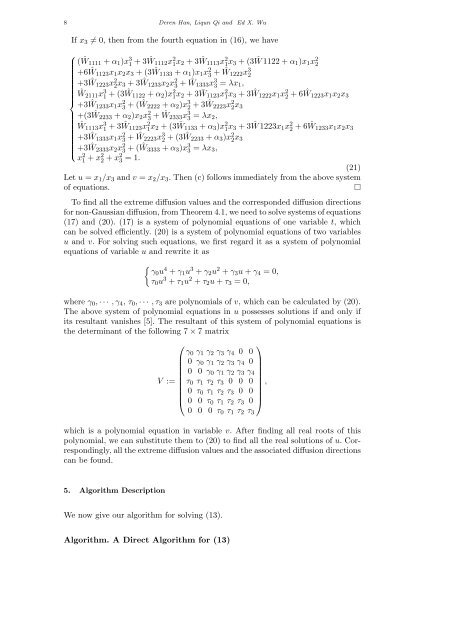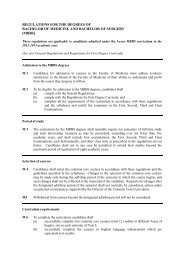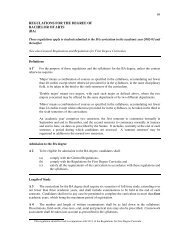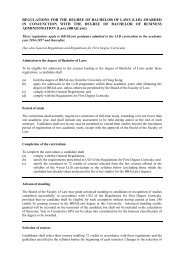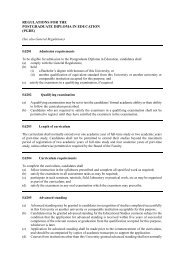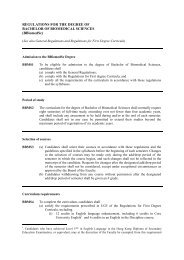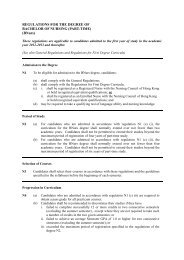RESEARCH ARTICLE Extreme Diffusion Values for non-Gaussian ...
RESEARCH ARTICLE Extreme Diffusion Values for non-Gaussian ...
RESEARCH ARTICLE Extreme Diffusion Values for non-Gaussian ...
You also want an ePaper? Increase the reach of your titles
YUMPU automatically turns print PDFs into web optimized ePapers that Google loves.
8 Deren Han, Liqun Qi and Ed X. Wu<br />
If x 3 ≠ 0, then from the fourth equation in (16), we have<br />
⎧<br />
(Ŵ1111 + α 1 )x 3 1 + 3Ŵ1112x2 1 x 2 + 3Ŵ1113x 2 1 x 3 + (3Ŵ 1122 + α 1)x 1 x 2 2<br />
+6Ŵ1123x 1 x 2 x 3 + (3Ŵ1133 + α 1 )x 1 x 2 3 + Ŵ1222x 3 2<br />
+3Ŵ1223x 2 2 x 3 + 3Ŵ1233x 2 x 2 3 + Ŵ1333x 3 3 = λx 1,<br />
Ŵ 2111 x<br />
⎪⎨<br />
3 1 + (3Ŵ1122 + α 2 )x 2 1 x 2 + 3 ¯W 1123 x 2 1 x 3 + 3Ŵ1222x 1 x 2 2 + 6Ŵ1223x 1 x 2 x 3<br />
+3Ŵ1233x 1 x 2 3 + (Ŵ2222 + α 2 )x 3 2 + 3Ŵ2223x2 2 x 3<br />
+(3Ŵ2233 + α 2 )x 2 x 2 3 + Ŵ2333x 3 3 = λx 2,<br />
Ŵ 1113 x 3 1 + 3Ŵ1123x2 1 x 2 + (3 ¯W 1133 + α 3 )x 2 1 x 3 + 3Ŵ 1223x 1x 2 2 + 6Ŵ1233x 1 x 2 x 3<br />
+3Ŵ1333x 1 x 2 3 + Ŵ2223x 3 2 + (3Ŵ2233 + α 3 )x 2 2 x 3<br />
⎪⎩<br />
+3Ŵ2333x 2 x 2 3 + (Ŵ3333 + α 3 )x 3 3 = λx 3,<br />
x 2 1 + x2 2 + x2 3 = 1. (21)<br />
Let u = x 1 /x 3 and v = x 2 /x 3 . Then (c) follows immediately from the above system<br />
of equations.<br />
□<br />
To find all the extreme diffusion values and the corresponded diffusion directions<br />
<strong>for</strong> <strong>non</strong>-<strong>Gaussian</strong> diffusion, from Theorem 4.1, we need to solve systems of equations<br />
(17) and (20). (17) is a system of polynomial equations of one variable t, which<br />
can be solved efficiently. (20) is a system of polynomial equations of two variables<br />
u and v. For solving such equations, we first regard it as a system of polynomial<br />
equations of variable u and rewrite it as<br />
{<br />
γ0 u 4 + γ 1 u 3 + γ 2 u 2 + γ 3 u + γ 4 = 0,<br />
τ 0 u 3 + τ 1 u 2 + τ 2 u + τ 3 = 0,<br />
where γ 0 , · · · , γ 4 , τ 0 , · · · , τ 3 are polynomials of v, which can be calculated by (20).<br />
The above system of polynomial equations in u possesses solutions if and only if<br />
its resultant vanishes [5]. The resultant of this system of polynomial equations is<br />
the determinant of the following 7 × 7 matrix<br />
⎛<br />
⎞<br />
γ 0 γ 1 γ 2 γ 3 γ 4 0 0<br />
0 γ 0 γ 1 γ 2 γ 3 γ 4 0<br />
0 0 γ 0 γ 1 γ 2 γ 3 γ 4<br />
V :=<br />
τ 0 τ 1 τ 2 τ 3 0 0 0<br />
,<br />
⎜ 0 τ 0 τ 1 τ 2 τ 3 0 0<br />
⎟<br />
⎝ 0 0 τ 0 τ 1 τ 2 τ 3 0 ⎠<br />
0 0 0 τ 0 τ 1 τ 2 τ 3<br />
which is a polynomial equation in variable v. After finding all real roots of this<br />
polynomial, we can substitute them to (20) to find all the real solutions of u. Correspondingly,<br />
all the extreme diffusion values and the associated diffusion directions<br />
can be found.<br />
5. Algorithm Description<br />
We now give our algorithm <strong>for</strong> solving (13).<br />
Algorithm. A Direct Algorithm <strong>for</strong> (13)


